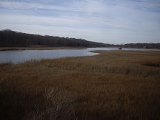
Fort Corchaug Archeological Site
Encyclopedia
Fort Corchaug Archeological Site is an archaeological site
showing evidence of 17th century contact between Native Americans
and Europeans. Fort Corchaug itself was a log fort built by Native Americans. It may have been to protect the Corchaug
tribe from other Indians, built with the help of Europeans. Ralph Solecki
, a prominent American archaeologist, grew up nearby and conducted several digs on site.
It remains today one of the few undisturbed Indian Fort archaeological sites in the North East. and was declared a National Historic Landmark
in 1999.
Archaeological site
An archaeological site is a place in which evidence of past activity is preserved , and which has been, or may be, investigated using the discipline of archaeology and represents a part of the archaeological record.Beyond this, the definition and geographical extent of a 'site' can vary widely,...
showing evidence of 17th century contact between Native Americans
Native Americans in the United States
Native Americans in the United States are the indigenous peoples in North America within the boundaries of the present-day continental United States, parts of Alaska, and the island state of Hawaii. They are composed of numerous, distinct tribes, states, and ethnic groups, many of which survive as...
and Europeans. Fort Corchaug itself was a log fort built by Native Americans. It may have been to protect the Corchaug
Metoac
Metoac is the collective name for the group of culturally and linguistically related Native American settlements roughly east of what is now the Nassau County line on, Long Island in New York at the time of European contact in the 17th century. Metoac does not specifically refer to political,...
tribe from other Indians, built with the help of Europeans. Ralph Solecki
Ralph Solecki
Ralph Stefan Solecki is an American archaeologist. He was born in New York City, New York in 1917. He is a former member of the faculty at Columbia University , and his best-known excavations were at the Neanderthal site at Shanidar Cave in Iraq. His publications include early works on aerial...
, a prominent American archaeologist, grew up nearby and conducted several digs on site.
It remains today one of the few undisturbed Indian Fort archaeological sites in the North East. and was declared a National Historic Landmark
National Historic Landmark
A National Historic Landmark is a building, site, structure, object, or district, that is officially recognized by the United States government for its historical significance...
in 1999.

